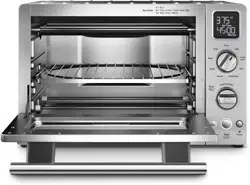Documents: Go to download!
- Owner's manual - (English, French, Spanish)
- PARTS AND FEATURES
- COOKING MODES GUIDE
- TOASTING MODES
- ADDITIONAL FUNCTIONS
- GETTING STARTED
- OPERATING THE COUNTERTOP OVEN
- TIPS FOR GREAT RESULTS
- CARE AND CLEANING
- TROUBLESHOOTING
Table of contents
User Manual Toasters
PARTS AND FEATURES
Parts and accessories

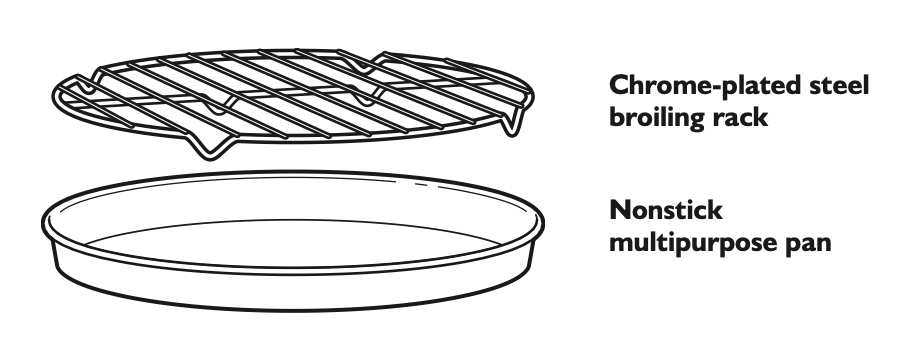
Control panel features

Selecting oven rack positions
Follow these guidelines to position rack:

- (Top)
Use for broiling most meats. - (Middle)
Optimal for most baking and cooking operations, including pizza, reheating, general cooking, and convection baking. Must use this setting for toast. Suitable for broiling some taller items. - (Bottom)
The bottom rack position leaves plenty of height for cooking taller items. Use this position for Asado Roast mode, and for reheating and warming.
COOKING MODES GUIDE
Your Countertop Oven features 9 cooking modes specially designed for a variety of cooking tasks. Each uses the KitchenAid ® Even-Heat™ system to control a combination of elements, applying heat where it’s needed for optimal results. Memory settings allow you to customize the time and temperature in each mode to fit your specific needs. The Countertop Oven will remember all your settings for the next use (until unplugged). The additional Convection and Frozen functions (available on certain cooking modes) allow you to take countertop cooking to a whole new level.
Refer to the quick guide below for Cooking Mode options, or see detailed explanations and tips for each cooking mode on the following pages.
COOKING MODES
Preheat is not required for Keep Warm, Reheat, Broil modes.
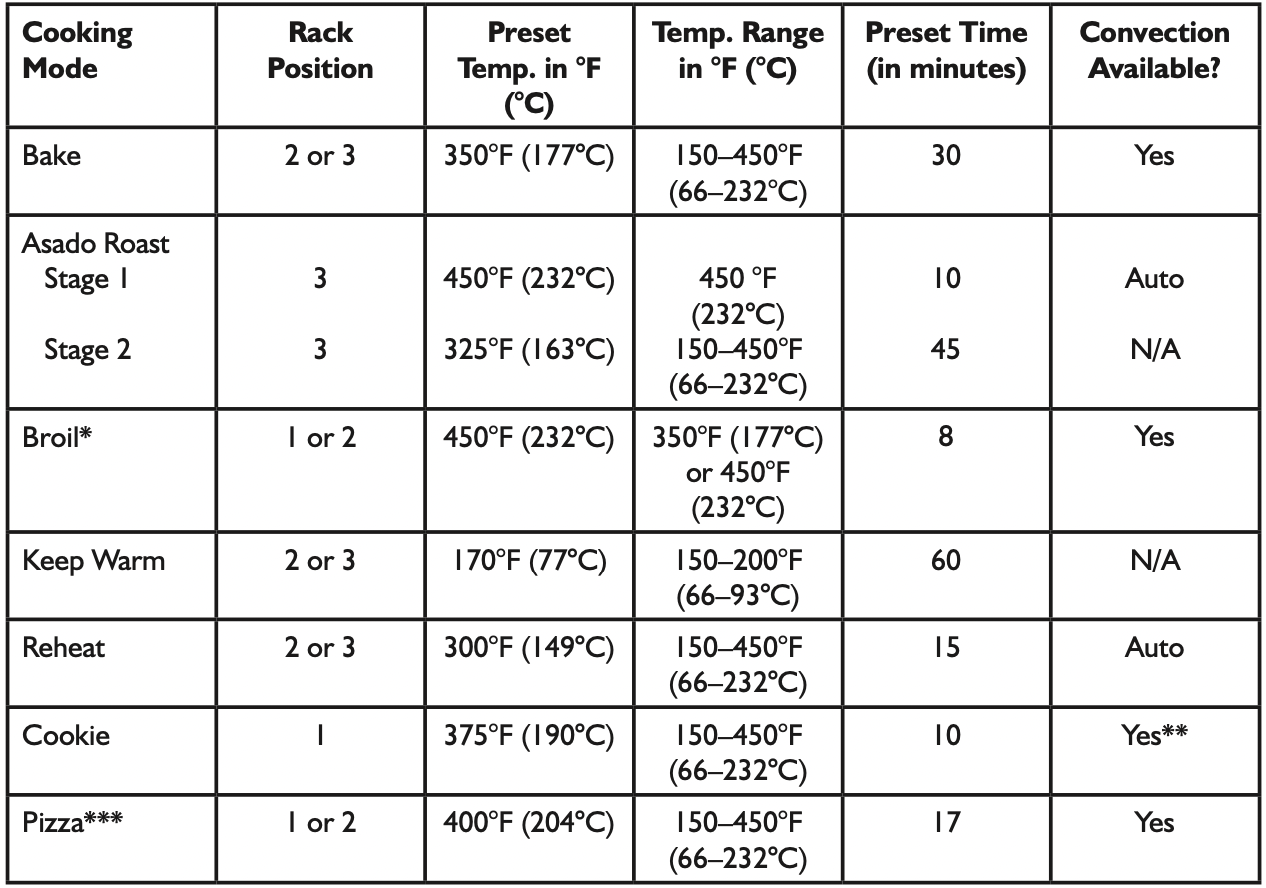
* Broil mode allows selection between 350°F (177°C) and 450°F (232°C) options only.
** When using Convection with Cookie mode, cooking temperature is automatically adjusted down by 25°F.
*** Pizza mode includes a 30 second Broil time at the end of the cooking cycle to brown cheese.
TOAST AND BAGEL MODES
Preheat is not required for Toast or Bagel modes.

What is Even-Heat™ technology?
The KitchenAid ® Even-Heat™ system helps provide consistent cooking results, without cold spots or overcooking. By cycling different heating elements on and off, and using certain elements for only part of the cooking cycle, Even-Heat™ allows tender, juicy roasts or pizzas with deliciously browned cheese—automatically.

Bake
In Bake mode, the Even-Heat™ system distributes power to the top and bottom heating elements to maintain the desired oven temperature. The top center element will be off.
Bake mode tip
- Food may finish cooking up to 30% faster when using Convection mode. Check baked goods such as cakes, muffins, and pastries before the expected finish time to avoid over-cooking.
NOTE: For temperature and time settings and options in Bake mode, see the “Cooking modes” chart.
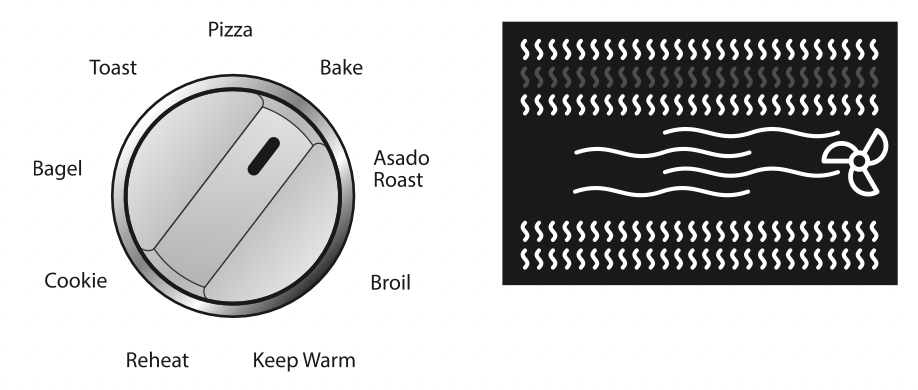
Asado Roast
The Asado Roast mode uses staged cooking to allow larger items like whole chickens or pork roasts to develop a crispy crust while slowly cooking the interior. The Even-Heat™ system distributes power to the top and bottom heating elements to maintain the desired oven temperature. The convection fan will operate in the first stage to assist with crisping the roast exterior, and will then turn off to prevent over-drying.

Temperature & time information
In Asado Roast mode, the time and temperature is set in 2 stages.
Stage 1 (Crisping) During Stage 1, the outer layer of your roast will crisp as the interior begins to warm. The convection fan will default to ON to assist with crisping the roast exterior, but may be turned off, if desired. Smaller cuts of meat may require less crisping than larger roasts; please consult your recipe.
Stage 2 (Roasting) Temperature is reduced in Stage 2 to allow heat to slowly and evenly reach the center of your food until it arrives at the desired finish temperature. The convection fan will turn OFF to prevent overdrying the outside.
NOTE: For temperature and time settings and options in Asado Roast mode, see the “Cooking modes” chart.
Broil
Broiling uses direct radiant heat to cook food from above. The Even-Heat™ system will distribute power to all three top heating elements to deliver two levels of efficient broiling. The bottom elements will not be on.
Convection mode can be used with thin cuts of fish, eliminating the need for flipping.
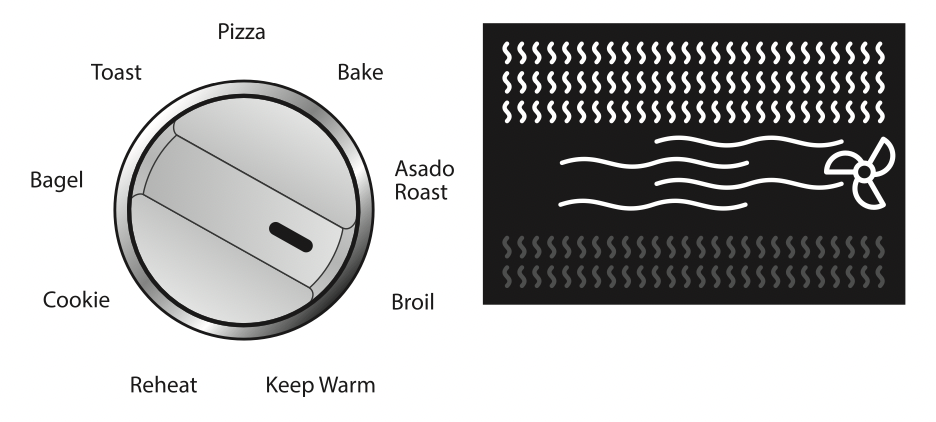
Broil mode tips
- For best results, use the 12" (30 cm) multipurpose pan and rack. It is designed to drain juices and help avoid spatter and smoke.
- For proper draining, do not cover the rack with foil. Instead, the bottom of the multipurpose pan may be lined with aluminum foil for easier cleaning.
- Foods cooked under the broiler will burn very quickly if not monitored near the end of their cooking times.
- Pull oven rack out before turning or removing food. Use tongs to turn food to avoid the loss of juices. Very thin cuts of fish, poultry, or meat may not need to be turned.
- After broiling, remove the pan and food from the oven. Drippings will bake on the pan if left in the heated oven, making cleaning more difficult.
NOTE: For temperature and time settings and options in Broil mode, see the “Cooking modes” chart.
Keep Warm
In Keep Warm mode, the Even-Heat™ system distributes power to the top and bottom elements to keep food warm before serving.
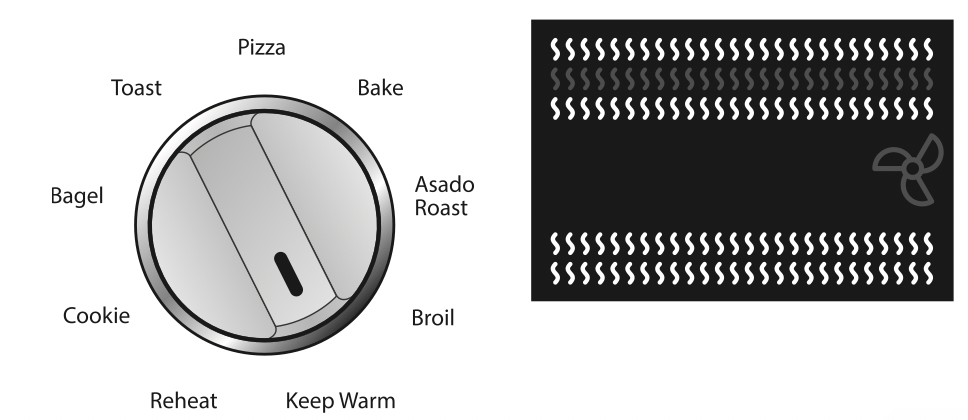
Keep Warm Tips
- The preset temperature is 170°F (77°C), but you may wish to adjust this depending on the item being warmed.
IMPORTANT: Food must be at serving temperature before it is placed in the oven to keep warm.
NOTE: For temperature and time settings and options in Keep Warm mode, see the “Cooking modes” chart.
Reheat
The Even-Heat™ system distributes power to the top and bottom elements to bring food to serving temperature. (The top center element is off.)

Reheat mode tips
- The preset suggested temperature is 300°F (149°C), but you may need to adjust this depending on the item being reheated.
- Reheating too long may over-cook or dry out food.
NOTE: For temperature and time settings and options in Reheat mode, see the “Cooking modes” chart.
Cookie
In Cookie mode, the Even-Heat™ system distributes power to the top and bottom heating elements to maintain the desired oven temperature. The top center element will be off.
When using Convection in Cookie mode, EasyConvect™ Conversion automatically reduces oven temperature by 25°F (14°C) to prevent overcooking.
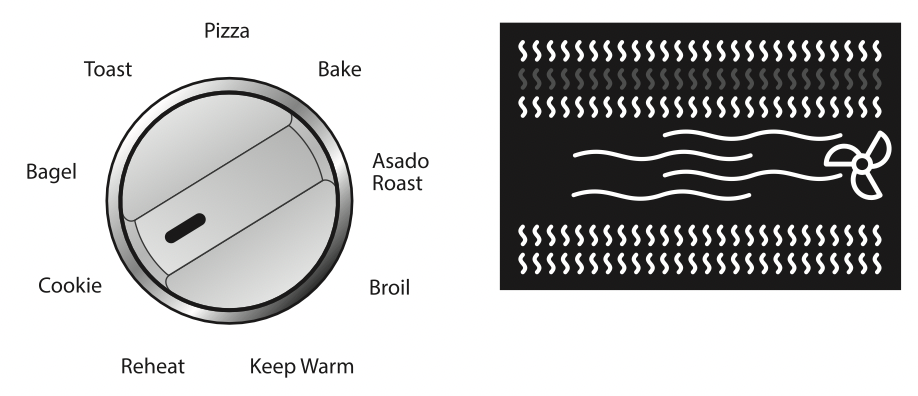
Convection tips for Cookie mode
- Cookies will cook faster and more efficiently in Convection Mode because their surface area is relatively small.
- Keep heat loss to a minimum by opening the oven door only when necessary.
- Cookies may finish cooking up to 30% faster when using Convection Mode. Check cookies before the expected finish time to avoid overcooking.
NOTE: For temperature and time settings and options in Cookie mode, see the “Cooking modes” chart.
Pizza
In Pizza mode, the Even-Heat™ system distributes power to the top and bottom heating elements to maintain the desired oven temperature. The top center element is off until the end of this mode. The last stage of this mode will finish off the cheese by browning with high heat.
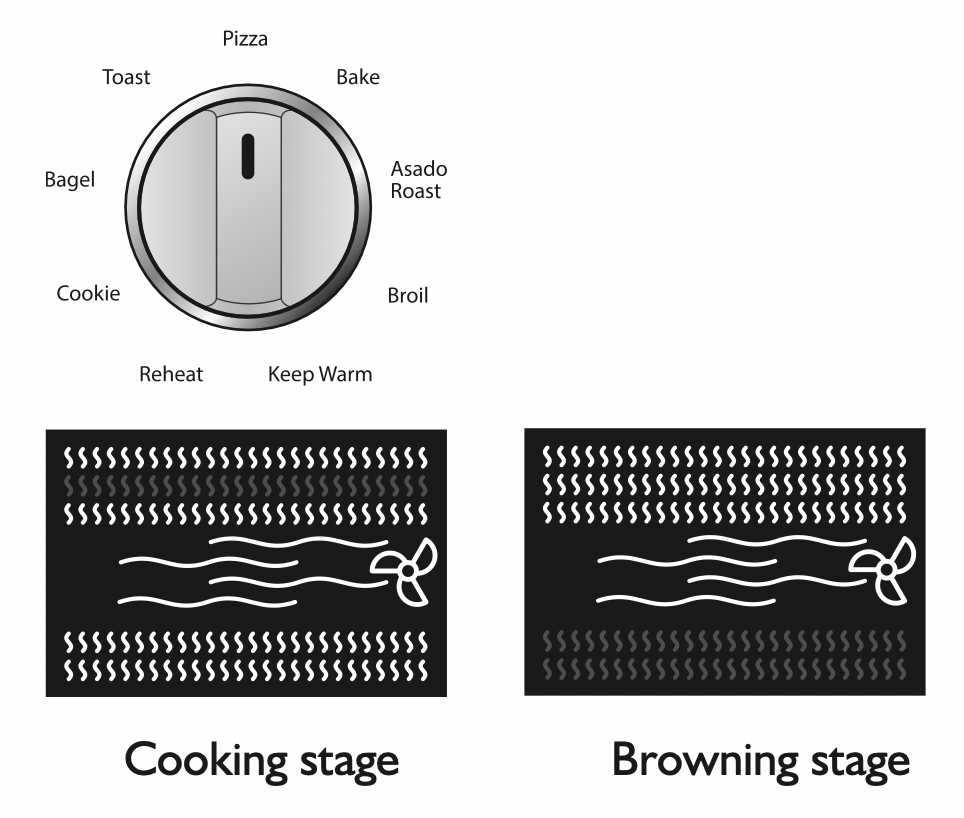
Frozen Mode
Pizza setting will default to frozen mode. You may use the Frozen button to provide extra time for frozen pizzas to cook, or deselect it when cooking freshly prepared pizzas.
Pizza mode tips
- For frozen pizzas, it is recommended to follow time and temperature directions included on the food packaging.
- Thin crust pizzas will cook faster and more efficiently in Convection Mode because their surface area is relatively small. Place thin crust pizzas directly on the oven rack for crispier crust. Please keep in mind that convection can speed up cooking time by up to 30%. You should check pizza often in the final minutes to ensure optimal results with this feature. Once you determine optimal time, reset your memory setting to the new desired time.
- Thick crust, self-rising, or deep-dish pizzas will require longer cooking times. Use the 12" (30 cm) nonstick pan for fresh or deep-dish pizzas to maintain shape and keep sauce contained.
- Pizzas may need to be rotated during cooking to ensure even results.
NOTE: For temperature and time settings and options in Pizza mode, see the “Cooking modes” chart.
TOASTING MODES
Toast
In Toast mode, the Even-Heat™ system distributes power between the top and bottom heating elements to deliver fast and even toasting.
Use the Toast mode for bread, toaster pastries, frozen waffles. If reheating pastries, use the Reheat function.
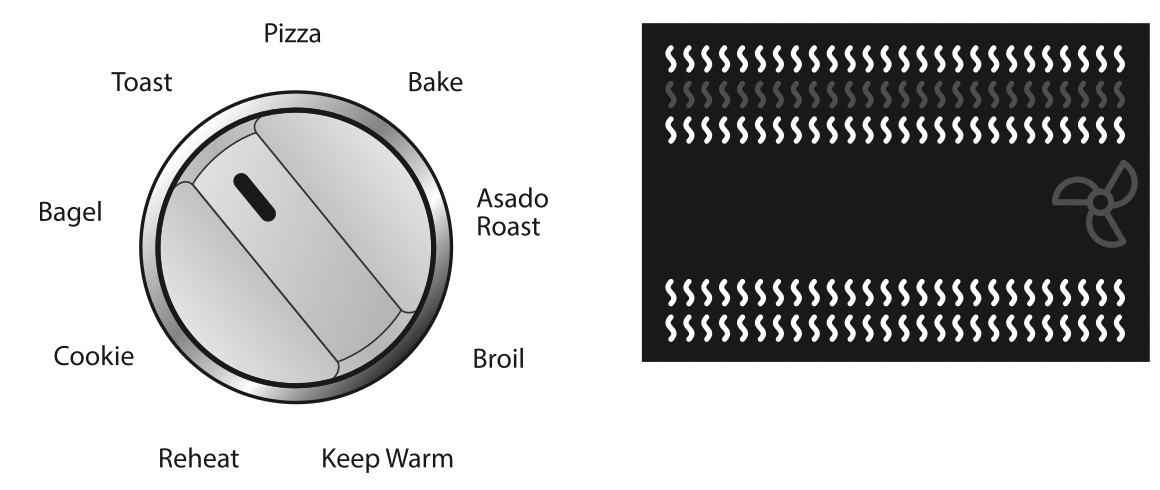
Toast mode tips
- Place bread directly on the middle position. It does not need to be flipped during the toasting cycle.
- Select the Frozen option to allow frozen bread or similar items extra time to thaw while cooking.
NOTE: For temperature and time settings and options in Toast mode, see the “Toast and bagel modes” chart.
Bagel
In Bagel mode, the Even-Heat™ system distributes power between the top and bottom heating elements to nicely brown the top of cut bagels while gently warming the outside.
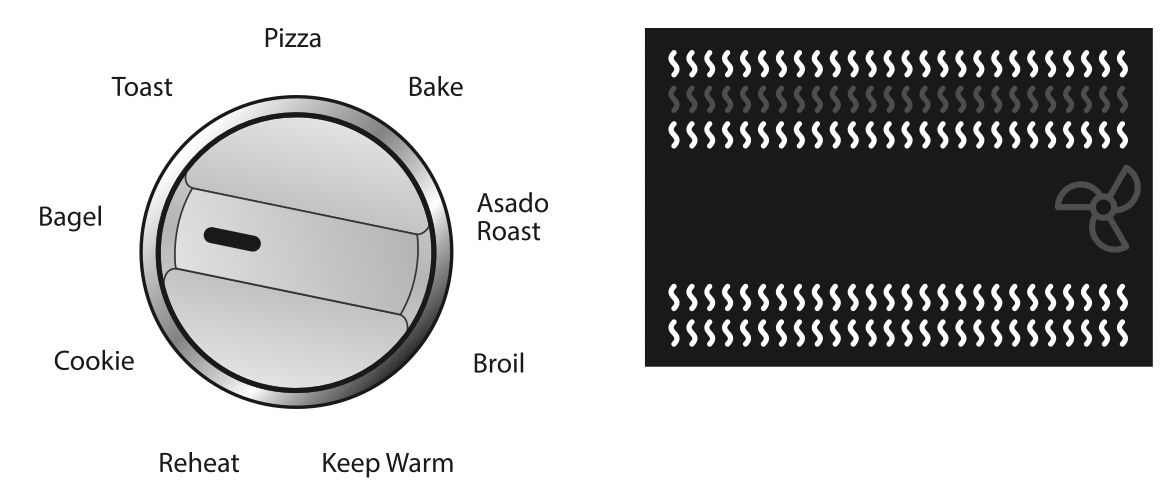
Bagel mode tips
- Place bagels directly on the oven rack with the cut sides facing UP. Bagels do not need to be flipped during the Bagel cycle.
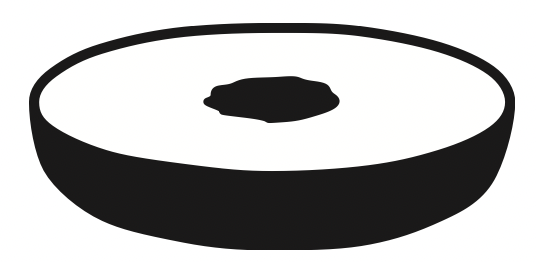
- Select the Frozen option to allow frozen bagels extra time to thaw while cooking.
NOTE: For temperature and time settings and options in Bagel mode, see the “Toast and bagel modes” chart.
ADDITIONAL FUNCTIONS
Convection option 
Convection cooking uses a fan to circulate air inside the oven to provide faster, more even cooking. The Convection option is available on most cooking modes. On Reheat and Stage 1 of Asado Roast, Convection will default to ON automatically. Convection is NOT available on Toasting modes.
When using Convection in Cookie mode, EasyConvect™ Conversion automatically reduces oven temperature by 25°F (14°C) to prevent overcooking.
Convection Mode Tips
- Thinner foods will cook faster and more efficiently in Convection Mode because their surface area is relatively small.
- Food may finish cooking up to 30% faster when using Convection Mode. Check baked goods such as cakes, muffins, and pastries before the expected finish time to avoid overcooking.
- Don’t cover foods with lids or aluminum foil so that surface areas remain exposed to the circulating air, allowing browning and crisping.
- Use pans with lower sides to promote better airflow.
Frozen option 
The Frozen option adds additional cycle time to the selected cooking mode to allow for thawing and proper cooking. The additional time varies depending on the selected cooking mode.
NOTE: The Frozen option is NOT available on Broil, Asado Roast, Reheat, or Keep Warm.
Changing between Fahrenheit and Celsius
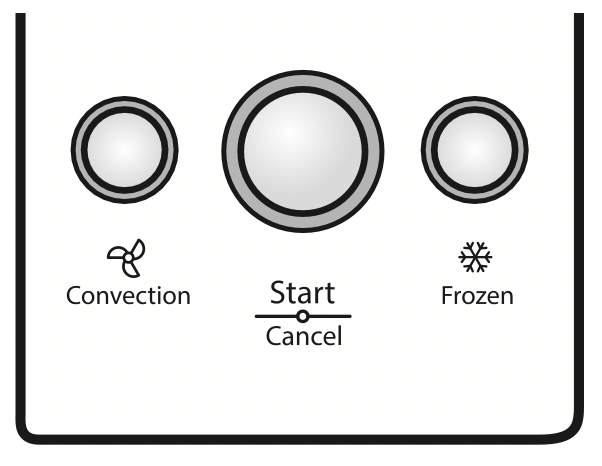
To change between degrees Fahrenheit and degrees Celsius, press and hold Convection and Frozen at the same time for about 3 seconds.
GETTING STARTED
Before first use
- Place the Countertop oven on a dry, flat, level surface such as a countertop or table.
- Be sure the sides, back, and top of the oven are at least 4" (10 cm) away from any walls, cabinets, or objects on the counter or table.
- Remove all accessories and wash in hot, sudsy water. Dry thoroughly before placing in the oven.
- Remove all packaging materials and labels, if present.
NOTE: Upon first use, the oven may produce light smoke. This is normal.

Using the Countertop Oven
WARNING - Electrical Shock Hazard
- Plug into a grounded 3 prong outlet.
- Do not remove ground prong.
- Do not use an adapter.
- Do not use an extension cord.
- Failure to follow these instructions can result in death, fire, or electrical shock.
- Plug into a grounded 3 prong outlet. The Countertop Oven should be the only appliance operating on the circuit. The Countertop Oven is now ready to use.
See other models: KCO275OB KCO273SS KRFC300ESS KRFF305ESS PRINTSHIELD
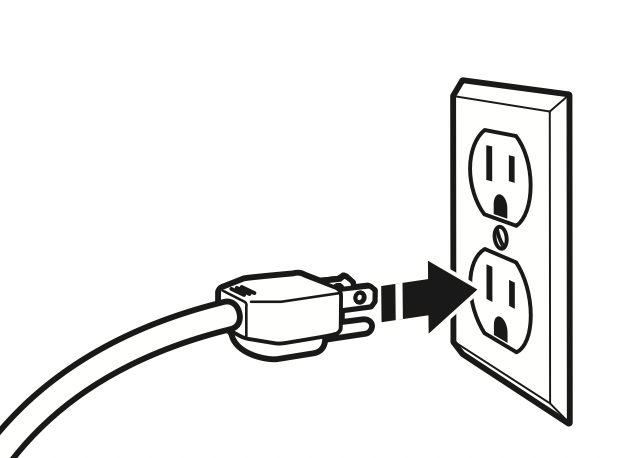
OPERATING THE COUNTERTOP OVEN
Adjusting the rack position
- To adjust oven rack position, slide the oven rack out completely.

- Align the sides of the oven rack with the grooves for the desired position and slide straight in.
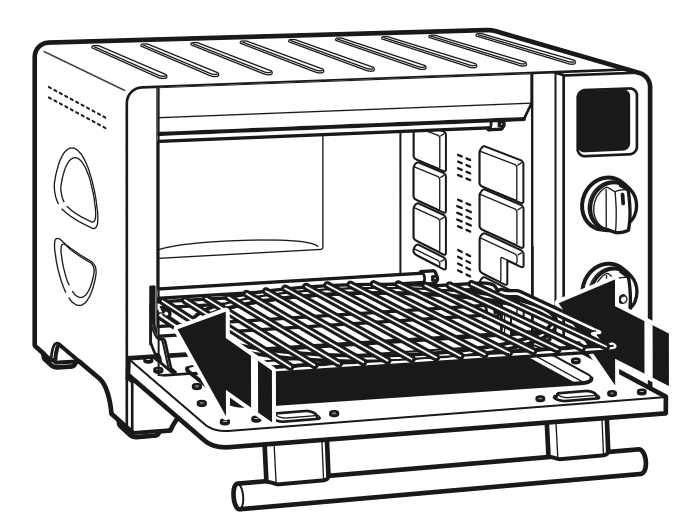
Setting a cooking mode
- Make sure there will be enough clearance between the top of the food item to be cooked and the top elements. If necessary, adjust oven rack position. Close the door.
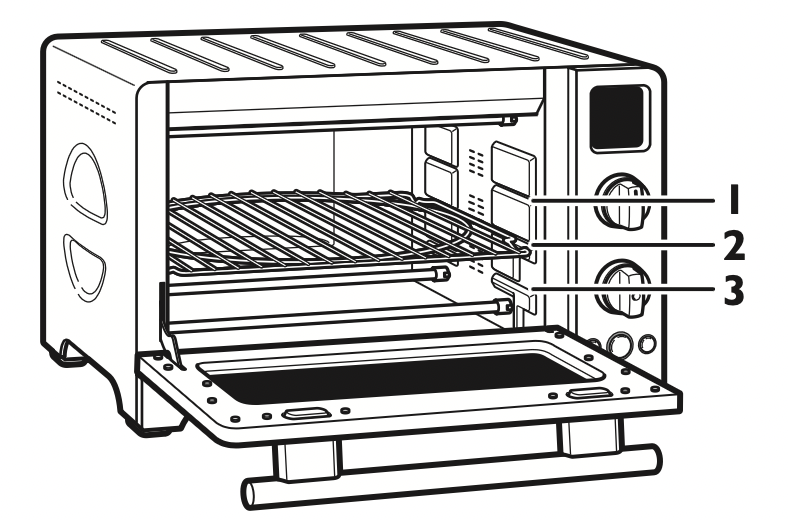
- Rotate the Mode knob to select the desired cooking mode. The preset temperature and time (shade and number of slices for Bagel and Toast mode) will be displayed.
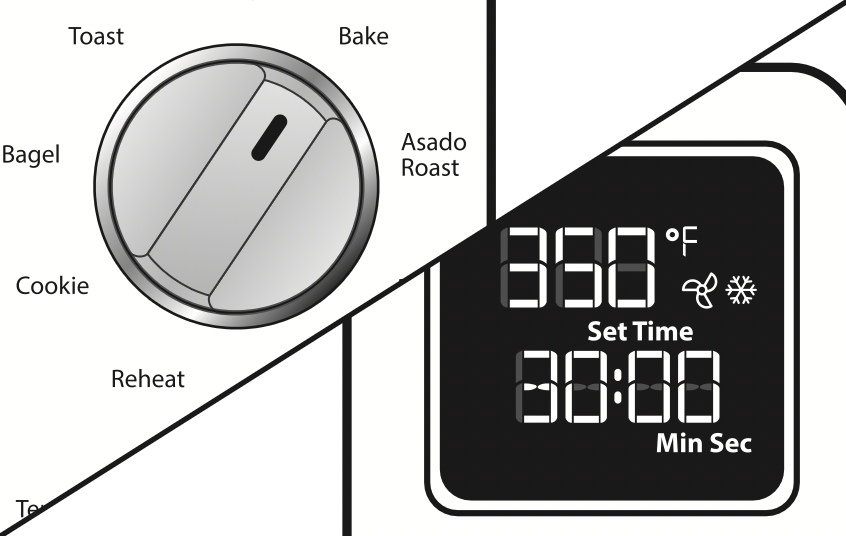
- Adjust the Temperature/Time control knob, if desired (See “Cooking Modes” and “Toast and Bagel Modes” charts for options). Press the knob to change between temperature and time. The selected field will blink in the display.

- Select CONVECTION or FROZEN options, if desired.
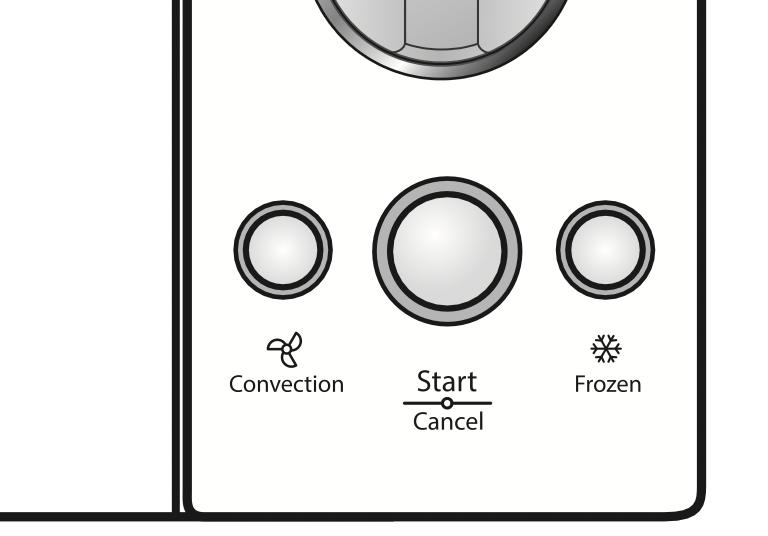
NOTE: Options not available with all Cooking Modes. See “Cooking Modes” chart and “Toast and Bagel Modes” chart for more information. - To preheat the oven, press START/ CANCEL. Once the oven reaches the desired temperature, a tone will sound.

NOTE: Preheating is not available on Broil, Keep Warm, Reheat, Toast, or Bagel modes. - Open the door, place the food to be cooked in the oven, and close the door. Press START/CANCEL again and the timer will begin counting down.
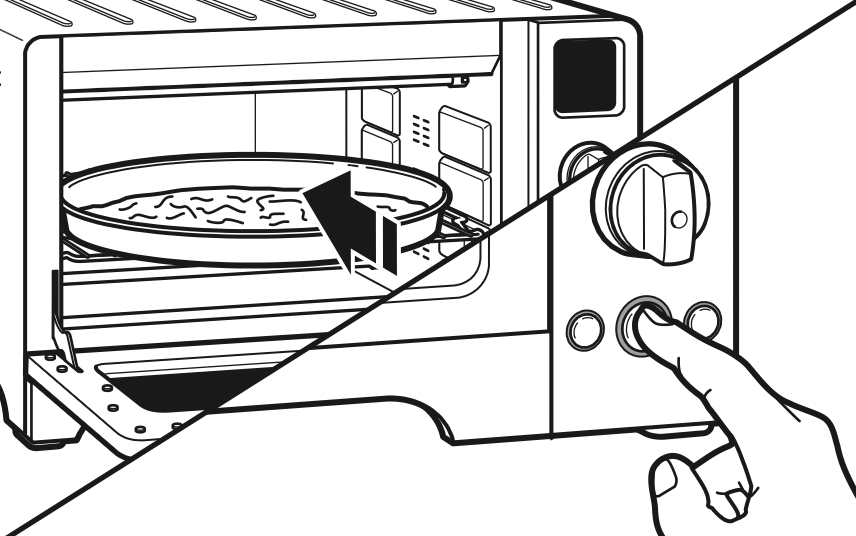
NOTE: If START/CANCEL is not pressed within 5 minutes of the Preheating complete tone, the oven will automatically turn off. - When the cooking cycle is complete, a tone will sound.
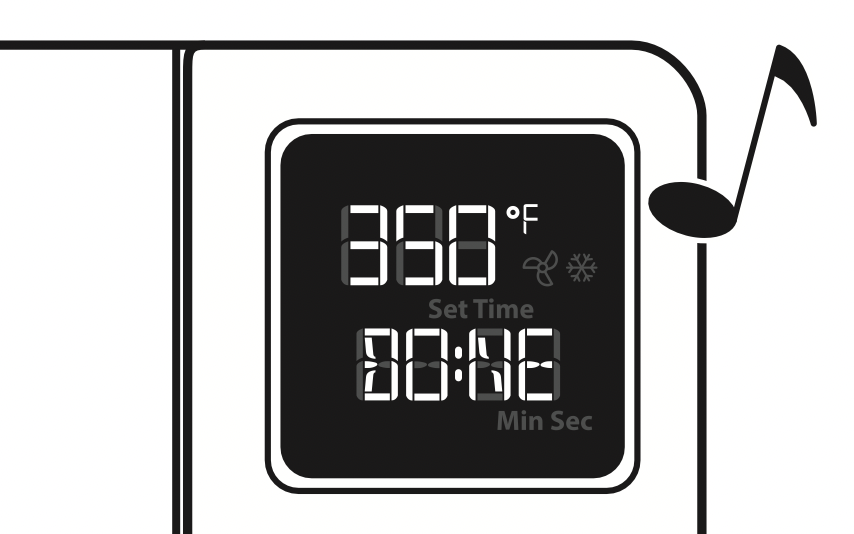
Preheating
Preheating your Countertop Oven is important for consistent and even results. Once you select your desired cooking mode and any other settings, and press START, Even-Heat™ Preheat saturates the oven walls and cooking racks above the oven’s set temperature to remove cold spots that draw heat away from food. This also helps the oven stay at the desired temperature when the door is opened for short periods of time.
During preheating, the light ring around the Start/Cancel button will be on, and the Preheat indicator will show on the LCD. Once the oven has reached the set temperature, a tone will sound to let you know you can insert food and begin cooking. Preheating is NOT necessary in all cooking modes.
TIPS FOR GREAT RESULTS
Countertop Oven use tips
Are guesstimates for Toast Mode OK?
Experience will teach you how much time to use for toasting various kinds of bread. Frozen, dark, or whole-grain breads require a longer time. Rye breads are the most susceptible to over-toasting and spot charring. Fresh, soft, or white breads require a shorter time.
For foods that melt
When cooking small pieces of food or foods that will melt, use the multipurpose pan. This will keep food from falling onto the cooking elements.
To minimize cleanup
Spray the multipurpose pan with nonstick cooking spray for easier cleanup when cooking wet or sticky foods. Wash pan thoroughly after each use to avoid buildup of cooking spray.
Size limits for food and cooking containers
For best results, food and/or oven-safe containers (see “Food Cooking Tips” section) must fit into the Countertop Oven without touching the cooking elements or inside walls of the Countertop Oven. The door must close completely. This allows air to circulate around the food, helping ensure consistent cooking temperature.
For extended use
When cooking for a long time at high temperatures, you may detect a slight odor from the Countertop Oven insulation materials. This is normal.
Food cooking tips
- Check food cooking progress through the clear, tempered glass door window. Your Countertop Oven wiII perform better and be more energy efficient if you open the door less often.
- If top of food item browns too fast, lower the oven rack position or reduce temperature. If bottom of food item browns too fast, raise rack position or reduce temperature. Please remember that adding the convection option could reduce the needed cooking time by up to 30%.
- Remove all plastic and/or paper wrappers from foods before cooking.
- Use only loosely covered oven-safe containers. Airtight containers may cause food to boil over or splatter.
- Although more energy efficient and faster than traditional ovens, countertop oven surfaces can become hot during cooking. Touch only the door handle and knobs during oven operation.
- Do not place items on top or near Countertop Oven while in use. Only use the included cooling rack to gently cool food on the top of this oven.
- Replace cardboard, glass, or plastic lids with aluminum foil for use in the Countertop Oven.
Choosing bakeware for Countertop Oven use
- The nonstick multipurpose pan included with the Countertop Oven is suitable for items such as cookies, rolls, biscuits, nachos, and pork chops.
- A variety of standard baking dishes, such as a 9" (23 cm) round or square cake pan, a 6-cup (1.5 L) muffin pan, small baking sheets, and 1 and 2 qt (0.95 mL and 1.9 L) round, square, and rectangular casserole dishes, may be used. The door must close completely.
- Choose bakeware made of metal, ovensafe glass, ceramic, or silicone.
- Use lowest oven rack position when using deep, oven-safe glass or ceramic containers and allow at least 1" (2.5 cm) clearance between the top of the container and the upper cooking elements.
- Do not use glass lids. If a cover is desired, use a loosely fitted sheet of aluminum foil shiny side up or down.
- Many convenience foods are packaged in nonmetallic containers only suitable for use in microwave ovens. Check package directions to determine whether the container is suitable for use in a regular oven.
CARE AND CLEANING
Removing and cleaning the crumb tray
The crumb tray should be emptied and cleaned at least after every few cooking cycles, or after any spills.
- To remove the crumb tray, grasp the grip underneath and slide straight out.

- Empty and wash in warm, soapy water, if needed. Dry with a soft cloth and slide back into place.

Cleaning your Countertop Oven
Unplug your Countertop Oven from the wall socket before cleaning.
- Allow Countertop Oven and accessories to cool completely before cleaning.
Interior:
- For easy cleaning, the inside walls of the Countertop Oven feature Ceramashield™, a nonstick ceramic coating. Remove heavy spatter after use with a nylon or polyester mesh pad, sponge, or cloth dampened with warm water. Dry with a paper towel or soft, dry cloth.
IMPORTANT: Do not use cleaning agents, cleansers, or metal scouring pads on the inner oven coating as they may reduce its effectiveness. The ceramic nonstick coating inside the oven is scratch-resistant. However, dropping or hard impacts can chip or crack the ceramic coating.
- Hand washing is recommended for racks and pan. Remove all items from the Countertop Oven. Wash the oven rack, broiling rack, and multipurpose pan in hot, sudsy water. Rinse and dry thoroughly.
NOTE: The oven rack, multipurpose pan, and broiling rack are dishwasher safe, but hand washing is recommended.
Exterior:
- Do not use abrasive cleaners or metal scouring pads. They could scratch the surface.
- For painted surfaces: Wipe the outside of the Countertop Oven with a clean, damp cloth and dry thoroughly.
- For stainless steel surfaces:
Wipe the outside of the Countertop Oven with a clean, damp cloth and dry thoroughly. A nonabrasive liquid cleaner may be used for stubborn stains. KitchenAid recommends the use of affresh ® stainless steel cleaner for all stainless steel surfaces. affresh ® cooktop cleaner and scrubbing pads are also recommended for cleaning the toughest baked-on residue on stainless steel and glass surfaces. Ensure all surfaces are completely dry before using your oven.
TROUBLESHOOTING
If your Countertop Oven malfunctions or fails to operate
WARNING - Electrical Shock Hazard
Plug into a grounded 3 prong outlet.
Do not remove ground prong.
Do not use an adapter.
Do not use an extension cord.
Failure to follow these instructions can result in death, fire, or electrical shock.
- Is the Countertop Oven plugged into a grounded 3 prong outlet?
Plug the Countertop Oven into a grounded 3 prong outlet. - Is the fuse in the circuit to the Countertop Oven in working order?
If you have a circuit breaker box, make sure the circuit is closed. Try unplugging the Countertop Oven, then plug it back in. - Upper cooking elements visibly glow, but bottom cooking elements do not.
The upper cooking elements use higher power for better browning performance. The lower cooking elements are on, but may not visibly glow like the upper cooking elements. This is normal and your Countertop Oven is working properly. - Power on light is flashing rapidly.
The Countertop Oven has a 2-hour auto shutoff feature. If the constant on feature is being used, the Countertop Oven will automatically shut off after 2-hours and the power on indicator light will flash rapidly. - If the problem cannot be corrected:
See the “KitchenAid Warranty and Service” sections. Do not return the Countertop Oven to the retailer retailers do not provide service.
